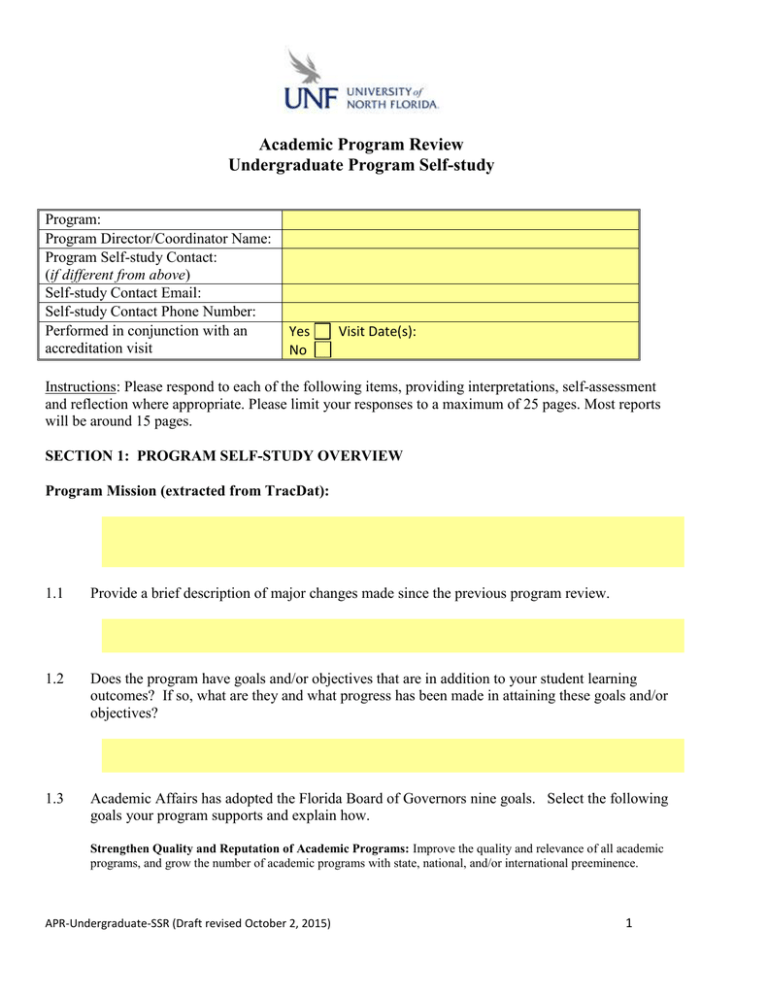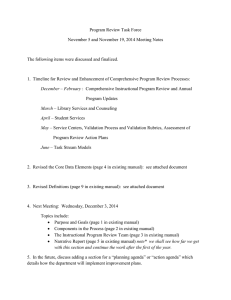Undergraduate Program Self-Study
advertisement

Academic Program Review Undergraduate Program Self-study Program: Program Director/Coordinator Name: Program Self-study Contact: (if different from above) Self-study Contact Email: Self-study Contact Phone Number: Performed in conjunction with an accreditation visit Yes No Visit Date(s): Instructions: Please respond to each of the following items, providing interpretations, self-assessment and reflection where appropriate. Please limit your responses to a maximum of 25 pages. Most reports will be around 15 pages. SECTION 1: PROGRAM SELF-STUDY OVERVIEW Program Mission (extracted from TracDat): 1.1 Provide a brief description of major changes made since the previous program review. 1.2 Does the program have goals and/or objectives that are in addition to your student learning outcomes? If so, what are they and what progress has been made in attaining these goals and/or objectives? 1.3 Academic Affairs has adopted the Florida Board of Governors nine goals. Select the following goals your program supports and explain how. Strengthen Quality and Reputation of Academic Programs: Improve the quality and relevance of all academic programs, and grow the number of academic programs with state, national, and/or international preeminence. APR-Undergraduate-SSR (Draft revised October 2, 2015) 1 Increase Degree Productivity and Program Efficiency: Increase access and degree completion for students, including students from traditionally underrepresented groups, returning adult students, and distance learning students. Increase the Number of Degrees Awarded in STEM and Other Areas of Strategic Emphasis: Increase student access and success in degree programs in STEM fields and other areas of strategic emphasis that respond to existing, evolving, and emerging critical needs and opportunities. Strengthen the Quality and Reputation of Scholarship, Research, and Innovation: Improve the quality and impact of scholarship, research, and commercialization activities, and grow the number of faculty/departments/centers recognized for their scholarship, research, and commercialization endeavors. Increase Research and Commercialization Activity: Increase research and commercialization activities to help foster entrepreneurial campus cultures. Increase undergraduate participation in research to strengthen the pipeline of researchers pursuing graduate degrees. Increase Collaboration and External Support for Research Activity: Attract more research funding from external (includes federal and private sources). Promote more collaboration with private industry on research projects. Strengthen the Quality and Recognition of Commitment to Community and Business Engagement: Improve the quality and relevance of public service activities and increase the recognition of commitment to community and business engagement. Increase Levels of Community and Business Engagement: Increase faculty and student involvement in community and business engagement activities. Increase Community and Business Workforce: Increase the percentage of graduates who continue their education or are employed in Florida. APR-Undergraduate-SSR (Draft revised October 2, 2015) 2 SECTION 2: PROGRAM COORDINATION AND ADMINISTRATION 2.1 Is there a program coordinator and/or program committee? If so, what does the program coordinator and/or program committee do? 2.2 Do you recruit students? If so, how? If not, why? 2.3 Do you advise and mentor students (academic & career)? If so, how? If not, why? SECTION 3: PROGRAM DEMAND AND PRODUCTIVITY 3.1 Examine the program enrollment data provided by the Office of Institutional Research and Assessment (refer to Appendix A). Explain the growth or decline in enrollment within your program and comment on the future potential demand for the program. 3.2 Limited Access Programs 3.2.1 By what means is access limited? Provide a description of the program’s admission requirements and procedures, and indicate how these requirements and procedures ensure equal access for Florida State College Associate of Arts degree graduates in the competition for available space in the program? 3.2.2 What semester(s) do you admit students? At what matriculation point(s) do you admit FTIC Students (e.g., sophomore, junior)? At what matriculation point(s) do you admit A.A. transfer students? What is your total anticipated admission capacity during the academic year? APR-Undergraduate-SSR (Draft revised October 2, 2015) 3 3.2.3 Is limiting access for the program still justified? If so, describe reasons why the program needs limited access status [Lack of Resources: number of faculty, instructional facilities, instructional equipment, external resources and/or Proficiency Requirements: audition / portfolio, GPA, accreditation requirements]. 3.2.4 Discuss the general quality of the program’s applicant pool (if applicable) over the review period. 3.3 Selective Admissions 3.3.1 Provide a description of the program’s admission requirements. Have these requirements changed since selective admission was implemented? If so, how? 3.3.2 How has the implementation of “selective admission” impacted the program? 3.3.3 Discuss the general quality of the program’s applicant pool (if applicable) over the review period. 3.4 Does your program contribute to the General Education Program? If so, how do you contribute to the general education assessment efforts? 3.5 Degree production Refer to the department and program data provided by the Office of Institutional Research and Assessment (refer to Appendix A) and current state thresholds for degree productivity (30 degrees within 5 years). If your program does not meet the state threshold, explain what strategies you are currently incorporating to increase degree production. APR-Undergraduate-SSR (Draft revised October 2, 2015) 4 SECTION 4: PROGRAM QUALITY 4.1 SCH production by full-time, visiting, part-time faculty and GTAs: Term Full-time Visitors Adjuncts GTAs Based on the data in the table above, does the program meet the 75% full-time/25% Adjunct ratio (visitors are considered full-time)? Are the full-time or visitor percentages going to change in the near future? If so, how and what is the projected impact on adjunct usage? 4.2 Discipline Accreditation 4.2.1 Does your program’s discipline have an accrediting agency? If so, what is it and what is your program’s status with the accrediting agency (e.g., accredited, candidate, seeking, not seeking)? 4.2.2 If the program’s status is candidate or seeking, where are you in the process? If the program’s status is not seeking, please explain why. 4.2.3 If applicable, discuss program accreditation results and the primary commendations, recommendations, and follow-up required. 4.3 Describe the overall program quality and describe the state, regional, and national reputation or recognition of the program. Identify the sources of the reputation or ranking indices. APR-Undergraduate-SSR (Draft revised October 2, 2015) 5 4.4 If applicable, provide licensure pass rates for the last 5 years. Include the total number of students attempting the exam and the total number who pass. 4.5 Discuss placement rates for graduates of your program (e.g., job placement rates, graduate school placement rates, types of jobs, caliber of graduate schools). 4.6 Have improvement initiatives been applied to the program in an effort to improve program quality and/or to respond to employer needs? If so, describe the improvement initiatives. 4.7 Refer to the program’s Academic Learning Compact and Assessment Report (refer to Appendix B) and student learning outcomes assessment results and plans. Describe how the student learning assessment process has resulted in program improvements over the last three years 4.8 Reflect on student perceptions of program quality based on appropriate data sources (e.g., institutional effectiveness assessment results, Graduating Senior Survey results, alumni survey data). SECTION 5: STUDENT CHARACTERISTICS AND QUALITY 5.1 Discuss the general quality of the program’s enrolled majors over the review period. 5.2 Provide a brief summary of student accomplishments during the review period in the following areas: a. awards at the national, regional, state, university and college levels APR-Undergraduate-SSR (Draft revised October 2, 2015) 6 b. significant scholarly and creative works and activities completed outside of regular classroom activity (e.g., publications, presentations, performances) - include the nature of the activity and the venue and note whether the activities were refereed or juried c. other noteworthy student accomplishments SECTION 6: CURRICULUM AND COURSE OFFERINGS Current program of study, extracted from the University catalog, is included in Appendix C. 6.1 Are there aspects of the curriculum that make the program distinctive? If so, what are they? 6.2 Does the program have interdisciplinary and/or international aspects? If so, describe them. 6.3 The State of Florida has identified Common Prerequisites for all university programs. Refer to the program prerequisites section of the program of study and compare them to the state common prerequisites located in Appendix C. Are the Common Prerequisites for the program still appropriate? If not, what needs to be altered and why? Is the program in compliance with the Common Prerequisites? If not, what steps will you take to bring the program into compliance? 6.4 Describe the typical rotation in which each course is offered (e.g., one section every fall term), noting any point during the past three years when the standard rotation was not followed and why. APR-Undergraduate-SSR (Draft revised October 2, 2015) 7 6.5 List any instructional sites off the main campus where any portion of the program is available via face-to-face instruction. What percentage of the program can be completed at the off campus instructional site? 6.6 What percentage of your program is available via a distance-learning mode of instruction? SECTION 7: STUDENT ENGAGEMENT 7.1 Does your program provide opportunities for students to engage in research and creative activities? If so, how? If not, why? 7.2 Does your program provide student internship opportunities? If so, is the internship required or optional? If optional, discuss participation rates. 7.3 Does your program have a clinical education component? If so, is the clinical education component required or optional? If optional, discuss participation rates. 7.4 Does your program provide any other engagement activities available to students in the program (e.g., co-op, community-based, service learning, study abroad)? If so, describe the activities and note whether they are required or optional? If optional, discuss participation rates. SECTION 8: 8.1 SWOT (Strengths, Weaknesses, Opportunities, & Threats) ANALYSIS Are there competing program(s) in Florida? If so, what are they and what is the impact on your program? APR-Undergraduate-SSR (Draft revised October 2, 2015) 8 8.2 Describe the program strengths? 8.3 Describe the program weaknesses? 8.4 Have any program barriers, threats, and/or unique vulnerabilities (e.g., loss of one faculty member may result in inability to offer program) been identified? If so, what are they? 8.5 Discuss potential opportunities in the following areas: a. actions to improve program quality b. new ventures to increase demand or improve competitiveness (e.g., internal or external partnership opportunities) c. actions to achieve productivity gains (e.g., recruitment, non-traditional instructional delivery systems) d. actions to improve efficiency and reduce cost e. other opportunities not addressed above APR-Undergraduate-SSR (Draft revised October 2, 2015) 9

